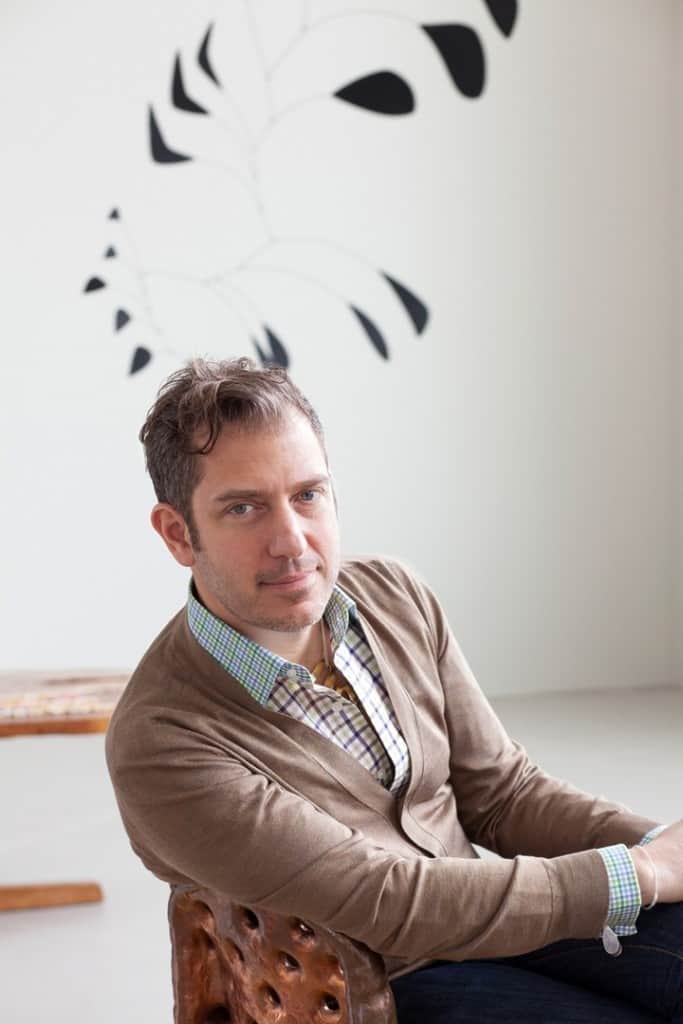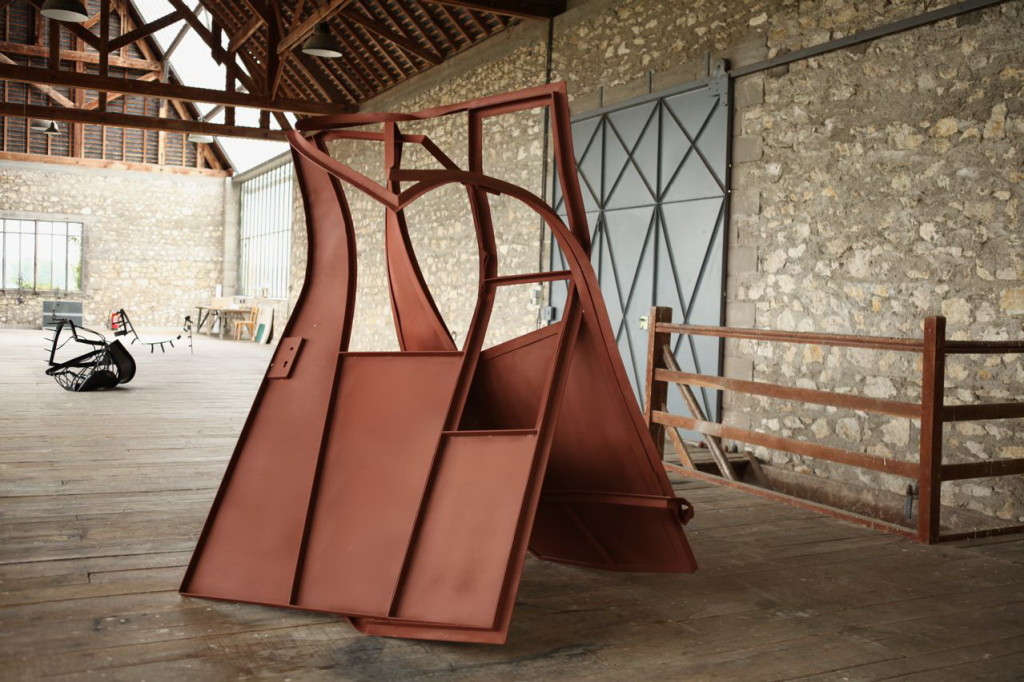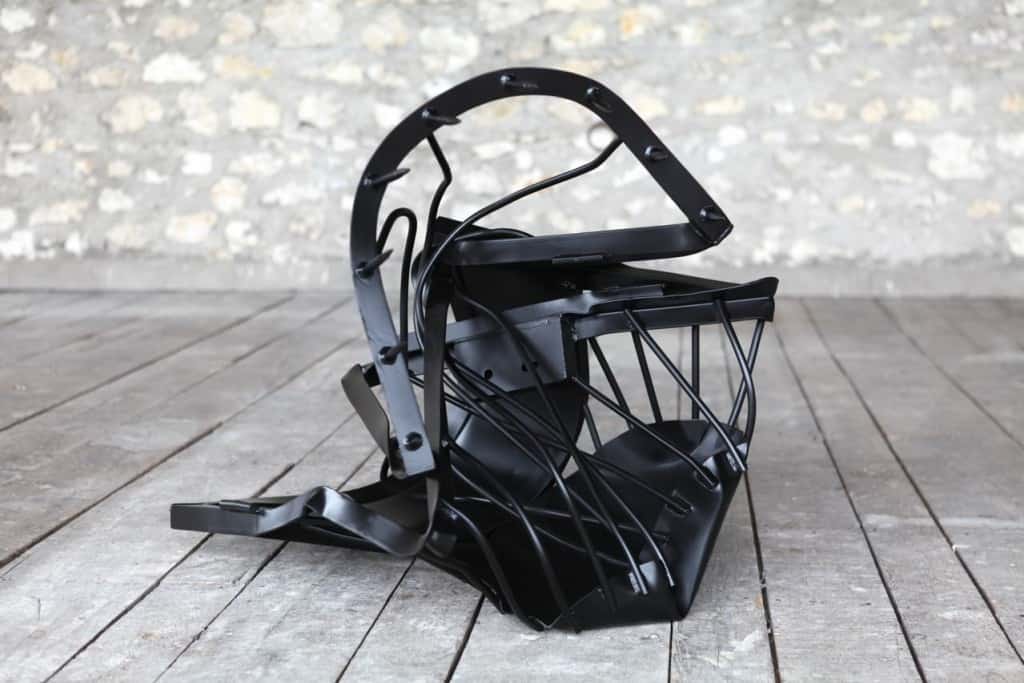During her residency at the Atelier Calder, Monika Sosnowska revisited the theme of the “maquette,” an investigation into issues of scale and perception that she began in 2005. Sosnowska returned to this study in Saché, contrasting models to their final works, but through a new process, in which she ambitiously establishes a direct link with the Atelier Calder’s unique space through scale and materials. In the resulting installation, the artist created an enveloping and disorienting environment; objects that normally would not coexist in real scale are presented side by side, forcing us to reflect upon our relationship to the space.

Portrait of Alexander S. C. Rower, Photo: Maria Robledo © 2014 Calder Foundation, New York / Artists Rights Society, New York
DC: Approximately how many pieces were presented (counting both the maquettes and full-scale objects)? What is the range of dimensions for the larger pieces?
Are any of the models conceived to be non-viable at full scale, and would the perceptual sensation of this dissonance be a significant component of their being experienced?
ASCR: Sosnowska presented two full-scale sculptures and approximately thirty maquettes to the public following her residency. The artist created the maquettes with the intention of eventual enlargement.
DC: Can you go into more detail about how Sosnowska’s site specificity works in the Atelier Calder?
ASCR: Sosnowska’s sculptures are intimately tied to the environment in which they are conceived, sampling from preexisting architectural elements to create a looking glass that manipulates and exposes the physical and cultural dimensions of a space.
At the Atelier, Sosnowska has created her sculptures using Calder’s enlargement process, a classical approach that utilizes maquettes in order to realize large-scale work. The studio and its expansive surroundings served as an incredible source of inspiration for my grandfather’s monumental works, so it’s exciting to see how this environment has also influenced Monika throughout her residency.

Monika Sosnowska, Gate (work in progress)
2014, Steel, paint, 200 x 189.9 x 127 cm / 78 3/4 x 74 3/4 x 50 inches
© Monika Sosnowska, Photo Guillaume Blanc
Courtesy the artist and Hauser & Wirth,
DC: At this point, can you elucidate on what precisely is Calder’s “enlargement process” and how does it differ from the way other sculptors approach monumental work?
ASCR: Many contemporary artists conceptualize monumental works through digital renderings or technical drawings. Monika has a more classical approach, which is similar to Calder’s, in that she uses a maquette to visualize the final work.
Calder’s father and grandfather were both well known, classically trained sculptors. Watching them make plaster models prior to working in more expensive materials like bronze or marble had a great impact on him. Once he conceived the possibility of enlarging small sculptures, he began to sketch his ideas in sheet metal, drawing on, and cutting directly into the material. He used these maquettes to test the strength, form, and scale of the work, often enlarging them to intermediate sizes before moving forward with the final sculpture.
DC: In your view, is there an intuition of “object identity” which transcends scale? (For example, a musical passage in a very high register can be duplicated at a very low register but retains only a very partial perceptual identity.) Do you want the pieces on disparate scales to dramatize difference through the “pun” of their “sameness” or do you see their pairing as producing an aesthetic structure purely in the relationship of scale? Is there a fundamental threshold difference in experience between a shape enclosing a large volume and the same shape enclosing a small volume? How do you think about the qualities of experiencing volumes across scale thresholds?
ASCR: The transcendence of scale in Sosnowska’s sculpture is akin to the possibilities of a musical passage. A piece of sheet music is essentially a set of guidelines for a musician. If a score indicates an A-note and a musician plays it correctly, an A-note will sound from the musician’s instrument, for example. However, it’s unlikely that any two musicians would ever play the same piece of music exactly the same way. The human element in music transcends the precision of the musical instructions. And so it is with Sosnowska’s work. Her maquettes contain a set of possibilities for what a larger version of the same work might encompass. And yet they also contain an object identity all their own.
DC: Do the sculptural qualities of these works derive from their architectural metaphors? Do those metaphors qualify various curvatures, fragmentations, asymmetries, or abrupt discontinuities in the works as inflecting architectural viability? Does this dissonance project particular expressive or conceptual messages, and/or references?
ASCR: Without implicitly borrowing from architecture, Sosnowska’s work would have a very different agenda. It is through her art’s identification with architecture that it develops an uncanny autonomy, the driving force behind each work. Since many of the sculptures are defamiliarized objects and structures from our everyday urban experience, each carries with it a myriad of memories and associations, both personal and widespread. However, there is certainly a sense of renewal in the work, especially as it relates to the communist architecture.

Monika Sosnowska, Model for ‘Gate’, 2014 © Monika Sosnowska Courtesy the artist and Hauser & Wirth
DC: Speaking of the architectural metaphors, let us focus on the notion of the labyrinth, one of the artist’s recurrent themes. (I’m thinking in particular of the project for the 2007 Venice Biennale, in which Sosnowska compressed the steel skeleton of a Communist-era housing block.) Do you think that a maze as an architectural metaphor for a loss of dynamic memory — with its inherent impossibility of movement, confusion of the dead ends, etc. — goes beyond the cultural amnesia haunting this generation of Polish artists? Do you feel it is something universal?
ASCR: Although the work is entrenched in the Eastern European experience, Sosnowska uses this history to address something that is much more universal. Her use of the “labyrinth,” particularly in her corridor pieces, creates an anonymous space for contemplation and uncertainty, a space for waiting. By constructing this within the larger structure, she opens the space to a variety of new possibilities. I find this to be rather optimistic.
DC: How do you personally relate to the labyrinthine structure of the digital era, the continuous transference of memory, being both on the move, and being at a loss? — Is this something that attracted you to Monika’s work in the first place?
ASCR: Something that I love about Calder’s work is that it forces you to slow down and look carefully. It takes time to watch a mobile move through space, and the anticipation that builds while waiting for its movement is exhilarating.
Monika’s work operates in very much the same way. By amplifying an element of architecture and altering it, she’s able to create a sculptural interior that requires acknowledgement of the space around you, and you become very conscious of how your body relates to it. In an age characterized by excessive choice and exposure, the contemplative experiences that these artists have created are invaluable.
DC: Can you elaborate on what “parasitic structures” might be? (or, perhaps cite a concrete example from her earlier work.) — Is there an element of such a parasitage in the presentation?
ASCR: I think that there has always been an underlying element of parasitage in Monika’s work. By extracting particular elements from a space, she imbues each work with autonomous life, transforming the utilitarian into the post-functional, purely sculptural. Her sculptures inhabit their own spatiality, seeming to live off that of the host site.
What’s fantastic about the presentation at the Atelier is that Monika has chosen to use it as an opportunity to reexamine her earlier work. She’s created new maquettes of works that were originally produced in 2005, and presented these alongside fresh works and other, significant found objects. The installation portrays an artist’s personal journey. Visitors are confronted with objects that would not normally coexist in the same scale, resulting in an immersive, disorienting experience. In his late career, when he was largely focused on the creation of monumental sculpture, Calder also sometimes revisited his earlier work, mining maquettes made in the Thirties, Forties, and Fifties for inspiration to create on a larger scale. So in this way, elements of Monika’s process are not unlike Calder’s.

Monika Sosnowska, Gate, 2014, Steel, paint 75cm x 75cm x 82cm © Monika Sosnowska Courtesy the artist and Hauser & Wirth
The Calder Foundation, a nonprofit 501(c)3 organization founded in 1987 by Alexander S. C. Rower and the Calder family, is dedicated to collecting, exhibiting, preserving, and interpreting the art and archives of Alexander Calder and is charged with an unmatched collection of his works. The purposes of the Foundation include the furtherance of public knowledge and appreciation for the visual arts; the conduct of research in art history and related subjects, and the provision of the results of that research to the general public; and the provision of facilities and programs to assist the education and development of visual artists. The Foundation’s projects include collaborating on exhibitions and publications, organizing and maintaining the Calder archives, examining works attributed to Calder, and cataloguing the artist’s works. Over the past several years, the Calder Foundation has expanded its programming to include its own exhibitions, lectures, performances, and events on Calder as well as contemporary artists, including those whose work the Foundation supports through its biannual Calder Prize and the Atelier Calder residency program in Saché, France.
The Atelier Calder was created over twenty years ago by Calder’s wife, Louisa, and daughters, Sandra Calder Davidson and Mary Calder Rower, with the invaluable assistance of Stanley Cohen, Calder’s lawyer, long-time friend, and neighbor in Saché. Currently under the presidency of Alfred Pacquement, the Atelier Calder was established in conjunction with the Centre national des arts plastiques (CNAP) and receives additional financial support from the French Ministry of Culture and Communication (DRAC Centre), the Région Centre, and the Calder Foundation.










